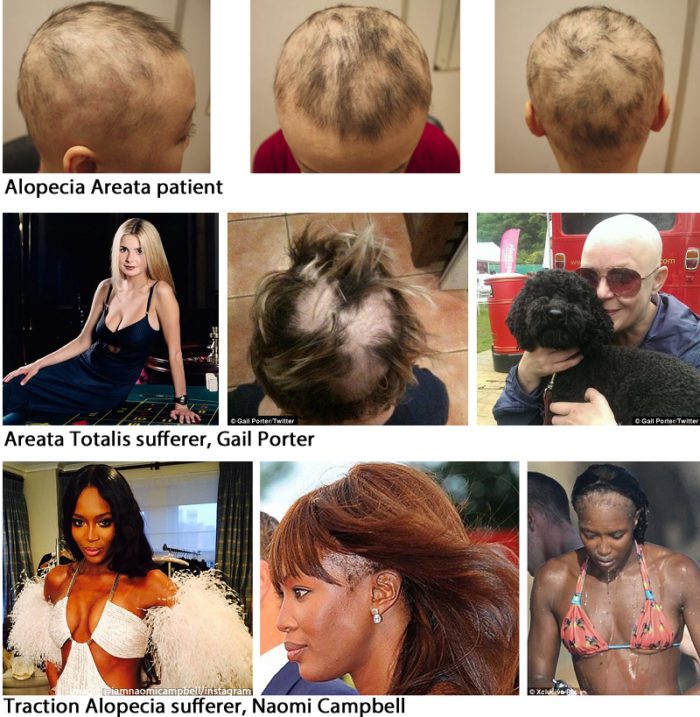It can be a little confusing, we know. Luckily, our team is here to guide you! And in September, Alopecia Awareness Month, we want to redefine our relationship with alopecia, a common, worldwide condition that should be talked about more openly. How? By responsibly informing our readers about it. If you’ve ever asked yourself “Do I have alopecia or hair loss?” then this blog is for you.
What is Alopecia?
Alopecia is, really, just the medical term used for hair loss. What type of hair loss? Any type. Yes, there’s more than one. There’s actually three main types of alopecia –more on that later– some being more severe than others.
Ultimately, they’re all an interruption to the body’s normal cycle of hair production. But there’s no reason to be afraid! It’s actually super common. In fact, over 1 in 5 Americans are losing their hair, with men representing a higher percentage of hair loss due to their higher genetic predisposition.
Alopecia, or the absence of hair, is usually most noticeable on the scalp, but can happen anywhere on the body where hair grows. Treatment depends on the type of baldness and its underlying cause.

How does Hair Loss happen?
It’s important to understand how alopecia happens. And in order to do so we need to talk about the hair growth cycle. This cycle consists of three phases.
The anagen phase, which lasts for years, is when hair grows actively. The catagen phase, lasting about 10 days, where hair stops growing and separates from its follicle. The telogen phase, where the follicle rests for two or three months, and ends with the hair “shedding”, or falling naturally out.
This cycle repeats itself all our life, becoming slower with age and other factors. But, if the cycle is interrupted or if a hair follicle is damaged, hair may quickly start to fall out faster than it is regenerated. Here’s when a receding hairline on one side, hair loss at temples, hair falling out in patches, or thinning hair begin to show up.
You may also like: Early Balding Signs
Types of Hair Loss
Androgenetic alopecia: Also called pattern alopecia, is the most common form of hair loss and affects both men and women. It is a genetically determined disorder and the symptoms vary by gender.
Male pattern baldness is characterized by loss of hair on the top and front of the head. Female pattern baldness is characterized by loss of hair on the top and crown of the head. Hair loss in women usually starts in the central part of the scalp. A high hairline, or balding hairline may also be a sign that a hair loss pattern has begun.
Alopecia areata: This is the most noticeable form of alopecia. It appears when the immune system attacks the hair follicles, affecting not just your head but everywhere else where there’s hair on the body. As a result, hair falls out in clumps.
The amount is different for everyone and in some cases it affects the eyebrows, eyelashes, and face. Some studies reveal that it can be generated by stressful situations but doctors don’t know why certain hair follicles are programmed to have a shorter growth period than others.
Traction alopecia: This type of hair loss is the result of constantly pulling your hair. The pulling can come from straining your scalp with the same hairstyle everyday –like ponytails– or by the use of weaves or dreadlocks. This type of alopecia can be avoided by taking better care of your hair.
So, what causes Alopecia?
Although every hair loss case is as different as the million individuals who suffer from it, some factors may strongly influence its appearance. Here are some of the most common:
-Systemic illness
-Genetic tendency
-Drugs
-Acute illness
-Hormonal imbalance
-Stress
-Local skin disorder
-Nutritional deficiency
Is there a Cure?
No matter how big or small your alopecia condition is, you are not alone. Actually, if you believe you are experiencing some kind of hair loss, we strongly recommend you visit a specialist to get early treatment.
There’s no permanent cure for alopecia. But there are treatments to decrease the body’s autoimmune reaction in the scalp and encourage hair regrowth. These include invasive but effective treatments like corticosteroid injections, surgical solutions like hair transplants, hair laser therapy or pharmaceutical options like medication and vitamins.
Non-Invasive and Healthy Solutions
If you are experiencing hair loss but are not entirely bald, you can opt for healthier and non-invasive solutions like hair thickeners or hair fibers. These work to immediately improve the look of thinning hair by concealing bald spots. Here’s how they work.
While hair loss by itself is not inevitable, it is optional. And by changing the way we relate to it, we let go of the frustration we may build around it.
So why not allow yourself to enjoy the healing benefits of hair loss solutions? And, therefore, into your well-being. Oh yeah, there’s SO much more to life than hair. But when it looks good, you feel even better. And that little form of self-love goes a long, long way.





